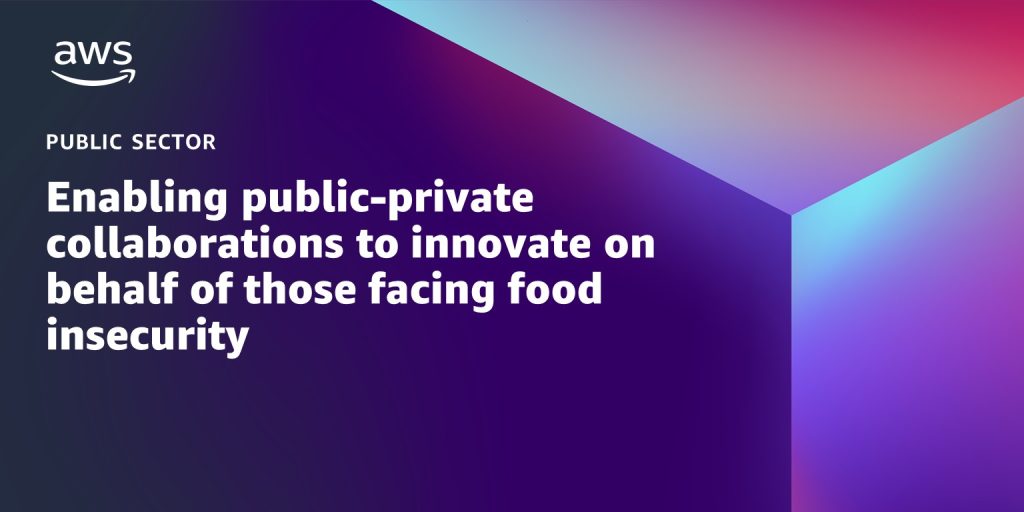AWS Public Sector Blog
Tag: state and local government
Enabling public-private collaborations to innovate on behalf of those facing food insecurity
Reducing food insecurity and increasing access to healthy foods is a major priority for state and federal agencies. Accelerating this work requires action and collaboration from state and local governments, the private sector, and more. AWS, Amazon Access, and state and local agencies are teaming up to rethink how to make eating healthy simple, nutritious, and cost-effective.
Top highlights from the 2023 IMAGINE: Education, State, and Local Leaders conference
From July 11-12, 2023, the IMAGINE: Education, State, and Local Leaders conference from AWS gathered public sector leaders from around the world in Sacramento, CA to reimagine the future of state and local government and education. At the keynote address, Kim Majerus, vice president of global education and US state and local government at AWS, shared stories of education and state and local organizations using cloud technology to provide meaningful services for their communities. Three guest speakers joined the stage to share how they’re using AWS to protect education services against the rising threat of cyber attacks, advance cutting-edge research, promote innovative citizen services, and more.
AWS announces inaugural State and Local Government Champions
AWS announced the winners of the inaugural State and Local Government (SLG) Champions Awards at the AWS Imagine Conference in Sacramento, California. The SLG Champions join the AWS Education Champions community, which was launched last year. The Champions program celebrates public sector agencies whose work empowers innovation and transformation in education and government using the AWS Cloud.
Using the cloud to integrate homelessness data with whole-person care services
Without a safe place to sleep at night, it’s hard to focus on employment, staying healthy, raising a family — the building blocks of a good life. In communities across the country, organizations, philanthropists, and government are working hard to make homelessness rare, brief, and nonrecurring. In many cases, they’re using AWS to coordinate their response.
Why unemployment insurance systems belong in the cloud
States are reevaluating the resiliency, security, and adaptability of their unemployment insurance (UI) systems. The AWS whitepaper, Why Unemployment Insurance Systems Belong in the Cloud, explores lessons learned from the pandemic – and provides opportunities for a path forward. While there’s no one-size-fits-all approach to modernization, we propose five tenets to anchor a vision of modern UI benefits systems and explore the different technical approaches to realize that vision.
Using data-driven solutions to end homelessness with the cloud
Community Solutions is a US-based nonprofit working to end homelessness through its Built for Zero program, a movement uniting with cities across the US to bridge strategy and support to reduce homelessness. The AWS Fix This podcast sat down with the Community Solutions team to see how it uses AWS to unlock data to measure and monitor its progress. Plus, representatives from the nonprofit Coming Home of Middlesex County, based in New Jersey, joined to discuss how Middlesex County and Community Solutions are working together to create a future where no one is left behind.
Register now for the IMAGINE 2023 conference for education, state, and local leaders
How can leaders transform good ideas into the kinds of services that change lives? That’s the central question of the IMAGINE conference from AWS, a two-day, no-cost event for state and local government and education leaders. From July 11-12, 2023 in Sacramento, CA, leaders from across state and local government and education will gather to learn more about how to transform public services to deliver for students, constituents, and communities. Will we see you there? Register now for the IMAGINE 2023 conference in Sacramento.
AWS launches first GovTech Accelerator to drive innovation in government
To help government technology (GovTech) startups build solutions that enable government agencies to better serve their communities, AWS is launching its first AWS GovTech Accelerator. This inaugural program is now accepting applications from startups interested in leveraging cloud-based resources to accelerate innovation. AWS wants to help startups develop solutions that address the needs of government agencies, with the first cohort focused on justice and public safety organizations including courts, corrections, emergency services, and law enforcement. Applications open today and close Monday, July 10, 2023.
Accelerating public health innovation with AWS Partners
Public health agencies are looking to modernize their infrastructure to make sure that their health solutions can scale equitably and reliably in any situation. Many governmental public health agencies across the US look to AWS and the AWS Partner Network to help them innovate quickly. Learn how AWS brought together three governmental public health agencies and partners to create scalable solutions that support public health.
AWS Marketplace announces new cooperative contract available through OMNIA Partners
AWS announced a new nationwide cooperative contract for AWS services, including AWS Marketplace, through OMNIA Partners. The Software Marketplace and Related Cloud Services cooperative contract is available to OMNIA Partners participating agencies, including state and local government agencies, public and private K12 school districts, and higher education organizations.









